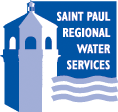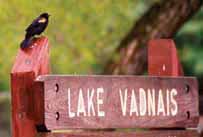Watershed Management and Reservoir Restoration Program
 The source water from the Mississippi River is pumped through a chain of natural lakes north of Saint Paul. When the lakes are at optimum elevations, there is an available supply of 3.6 billion gallons of water.In years past, excessive nutrients in the lake reservoir system created taste and odor problems. To address these problems, the utility and partnering neighbor municipalities, began a watershed management and reservoir restoration program.
The source water from the Mississippi River is pumped through a chain of natural lakes north of Saint Paul. When the lakes are at optimum elevations, there is an available supply of 3.6 billion gallons of water.In years past, excessive nutrients in the lake reservoir system created taste and odor problems. To address these problems, the utility and partnering neighbor municipalities, began a watershed management and reservoir restoration program.
Sampling Sites
The watershed strategy established 22 sampling sites, which helped identify the basic problem, which was nutrient enrichment created mainly by:
- Water from the Mississippi River and Rice Creek
- Recirculating reservoir sediments
- Runoff from local watershed Rainfall
Control Measures

Excessive nutrients, called “phosphorous loads”, increase the amount of blue-green algae which imparts taste and odor compounds. To inhibit the growth of excessive algae several controls were implemented:
- Installation of ferric chloride feed systems
- Installation of aerators
- Restoring water levels to near-natural conditions in certain wetlands
The control measures targeting the Mississippi source water and the lake sediment loads have successfully reduced the phosphorus concentration from approximately 60 to 80 micrograms per liter to 20 to 40 micrograms—very near the goal of 25 micrograms.
For example, restoration work on the Lambert Creek watershed area was selected by the Governor's Clean Water Initiative in 2004 as one of two metro area clean water projects. The addition of a weir, pond, and ditch in the watershed will help us reduce the phosphorus levels of water coming into Vadnais Lake.
Conclusion
Watershed and reservoir management has reduced significantly taste and odor problems in the reservoir system and increased the effectiveness of the plant treatment process. Due to improved raw water conditions there has been a significant reduction in chemical cost.This approach allows Saint Paul Regional Water Services to provide quality, cost-effective water that meets regulations and customer expectations.